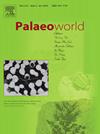The tibiotarsus of a giant darter from the upper Miocene of Amazonia and weight estimates for fossil darters
IF 1.7
3区 地球科学
Q2 PALEONTOLOGY
引用次数: 0
Abstract
Fossil darters are known from every continent since the Oligocene. However, it was in the Miocene of South America that this group reached its maximum diversity. Macranhinga ranzii is the largest darter from the Solimões Formation, described based on the left and right femora as well as the distal end of a tarsometarsus and four vertebrae. Here, we describe for the first time the left tibiotarsus of this species by comparing it with the tibiotarsus of the extant Anhinga anhinga and other fossil anhingids. We also calculated and compared the body mass of Ma. ranzii to that of all known tibiotarsi fossil anhingids using two calculation methods. The tibiotarsus described here is morphologically similar to that of other anhingids, however, in addition to its large size and robustness, it presents diagnostic characters (e.g., torus linearis) that allow us to attribute it to the genus Macranhinga and differentiate it from other fossil species of this genus whose tibiotarsi are known. The estimated body mass of Ma. ranzii ranges from 14.39 to 19.1 kg, ranking it the highest estimated body mass among the darters where the tibiotarsi were found.
来自亚马逊河中新世上部的一种巨型鲷鱼的胫跗和鲷鱼化石的重量估计
渐新世以来,每个大陆都有化石化石。然而,在南美洲的中新世,这个群体达到了最大的多样性。Macranhinga ranzii是Solimões组中最大的一种,根据左右股骨以及跗跗骨远端和四块椎骨来描述。本文首次将该物种的左胫跗骨与现存的足跖骨和其他足跖骨化石进行了比较。我们还计算和比较了马的体重。Ranzii与所有已知的tibiotarsi化石类人猿使用两种计算方法。这里描述的胫跗骨在形态上与其他类人猿相似,然而,除了它的大尺寸和健壮性外,它还表现出诊断特征(例如环面线性),使我们能够将其归为Macranhinga属,并将其与该属的其他已知胫跗骨化石物种区分开来。马的估计体重。Ranzii的体重范围在14.39到19.1公斤之间,是发现胫跗的鱼类中估计体重最高的。
本文章由计算机程序翻译,如有差异,请以英文原文为准。
求助全文
约1分钟内获得全文
求助全文
来源期刊

Palaeoworld
PALEONTOLOGY-
CiteScore
4.00
自引率
5.90%
发文量
95
期刊介绍:
Palaeoworld is a peer-reviewed quarterly journal dedicated to the study of past life and its environment. We encourage submission of original manuscripts on all aspects of palaeontology and stratigraphy, comparisons of regional and global data in time and space, and results generated by interdisciplinary investigations in related fields. Some issues will be devoted entirely to a special theme whereas others will be composed of contributed articles. Palaeoworld is dedicated to serving a broad spectrum of geoscientists and palaeobiologists as well as serving as a resource for students in fields as diverse as palaeobiology, evolutionary biology, taxonomy and phylogeny, geobiology, historical geology, and palaeoenvironment.
Palaeoworld publishes original articles in the following areas:
•Phylogeny and taxonomic studies of all fossil groups
•Biostratigraphy, chemostratigraphy, chronostratigraphy
•Palaeoecology, palaeoenvironment and global changes throughout Earth history
•Tempo and mode of biological evolution
•Biological events in Earth history (e.g., extinctions, radiations)
•Ecosystem evolution
•Geobiology and molecular palaeobiology
•Palaeontological and stratigraphic methods
•Interdisciplinary studies focusing on fossils and strata
 求助内容:
求助内容: 应助结果提醒方式:
应助结果提醒方式:


